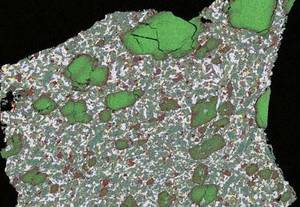A meteorite that fell to Earth in 2011 contains trapped samples of the Martian surface, interior and atmosphere.
Tissint, as the rock is known, landed in Morocco on the  18th July last year. Unlike previous Martian meteorites, this one was watched as it fell and was recovered quickly for analysis before it could be significantly contaminated by material from Earth.
18th July last year. Unlike previous Martian meteorites, this one was watched as it fell and was recovered quickly for analysis before it could be significantly contaminated by material from Earth.
Now scientists have published the first analyses of the material, concluding that Tissint contains material from Mars' surface, bubbles that are almost certainly filled with gas from the Martian atmosphere, and lumps of igneous rock erupted at some earlier time from the red planet's interior.
Writing in Science, Hassan II University Casablanca scientist Hasnaa Chennaoui Aoudjehane and her colleagues describe how the meteorite contains a glassy material within which is trapped these vestiges of the past on Mars.
The bubbles contain an excess of a certain isotope of nitrogen, which agrees exactly with data collected about the Mars atmosphere by the Viking probes in the 1970s.
The trapped surface material also seems to contain organic matter which the team disclosed by heating tiny fragments of the meteorite, and the presence of sulphur seems to suggest that the surface material was weathered for a time before it was ejected into space.
The researchers were also able to show, by looking for radioactive particles embedded into the rock's surface by the solar wind, that Tissint had been circling in space for about 750,000 years before it landed here.
According to Chennaoui Aoudjehane, the findings paint a picture of a rock that started life as an erupted basalt on the surface of Mars; it was weathered for a time by fluids that imparted to it elements from the planet's surface, including sulphates, which were deposited in fissures and cracks on the surface.
A subsequent impact, from outer space, caused the rock to partly melt, locking the surface material and bubbles of atmospheric gases inside. Ejected into space, the rock has been wandering aimlessly for three quarter of a million years until it crossed our path in 2011...
- Previous Gut viruses trigger AIDS
- Next Melanoma dodges immune attack










Comments
Add a comment